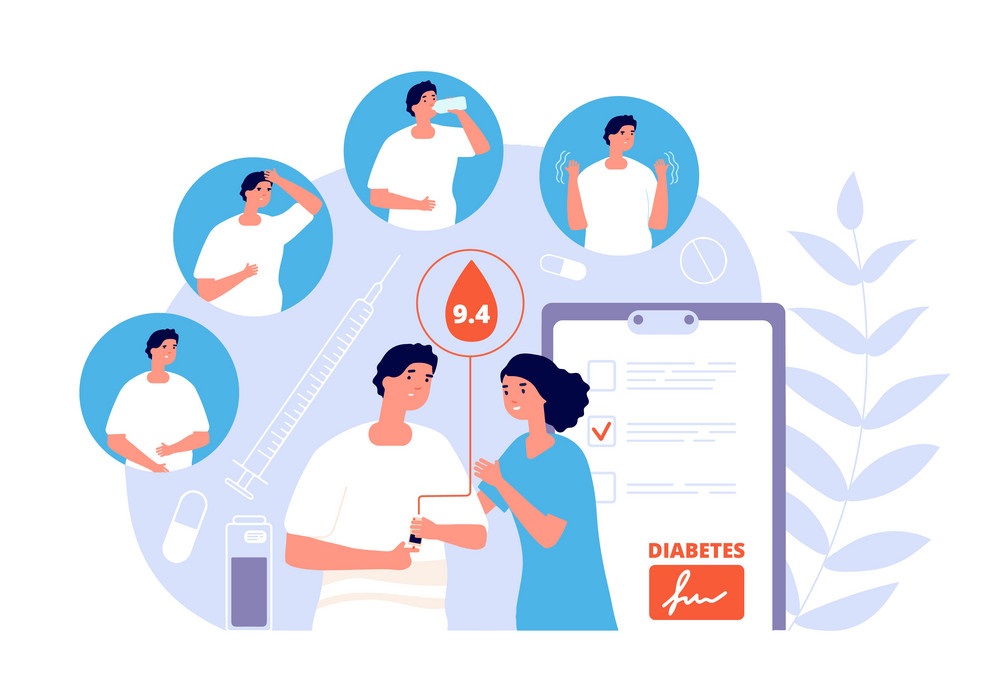When a patient has Type 1 diabetes and is admitted to the hospital, the inpatient team and the diabetic specialist nurse will need to evaluate the diabetes management based on the individual’s needs.
This article is designed to provide specific guidance to physicians, nurses, and other professionals caring for hospitalized patients who are receiving insulin infusion pumps.

It is meant to be a guide for providers regarding prescribing and infusing insulin via an infusion pump in the inpatient setting. Every patient and situation is unique; it is important to consider the site of care, resources at the facility, and each patient’s individual preferences.
Insulin Infusion Pump
The insulin infusion pump is a small, battery-powered device that delivers insulin to your body through a thin tube called a cannula. The pump is attached to you by a belt or pocket, and the cannula is inserted just under your skin. It’s often used by people with type 1 diabetes who need more than one daily injection of insulin.
Insulin pumps work by continuously infusing insulin at rates set by the user. This type of continuous delivery can be used in place of multiple daily injections with syringes or pens. The pump can also be used in combination with these other methods.

Advantages Of Insulin Infusion Pump
The advantages of using an insulin infusion pump include:
1. Convenience
Delivers insulin automatically at scheduled times and rates, which frees patients from having to remember to give themselves injections.
2. Accuracy
Provides an accurate dose of insulin and reduces the risk of user error.
3. Humane
This allows patients with diabetes to lead normal lives without dealing with the side effects associated with conventional insulin injections.
4. Self-Management
Permits patients to make decisions about their own health care without needing help from others.
Insulin Infusion Pump Management

Insulin infusion pumps are available in several forms and are used to administer insulin continuously or intermittently. The newer generation pumps provide bolus doses of rapid-acting insulin based on the current meal intake and basal rates of long-acting basal insulin. These pumps are designed for use by adults who are able to self-manage their diabetes and have had type 1 diabetes for several years. They may be considered for patients who require frequent blood glucose monitoring and require a high degree of flexibility in their diabetes management.
People with diabetes who are unable or unwilling to manage their own diabetes should not be considered candidates for an insulin pump unless they have a caregiver/family member willing and able to assist with the device’s use on a daily basis.
Benefits Of Insulin Infusion Pump Management
1. Decreased Risk Of Hypoglycemia
In order to manage diabetes effectively, it is important to have a good understanding of how insulin works and how much insulin you should be taking. The use of an insulin infusion pump helps people with diabetes manage their disease more efficiently by reducing the risk of hypoglycemia.
2. Improved Blood Glucose Control
Managing your blood glucose levels is the key to preventing complications of diabetes such as heart disease, eye problems, nerve damage, and kidney failure. Using an insulin infusion pump can help you achieve better blood glucose control because it allows you to calculate the amount of rapid-acting insulin needed to cover meals and snacks more accurately than with multiple daily injections (MDI). The pump also allows you to change basal rates during the day, which can help reduce high blood sugars that occur overnight or during sleep.

3. Greater Freedom From MDIs
The pump does not require you to carry syringes or wear a separate device on your body, so this gives people with diabetes greater freedom from MDIs and makes it easier for them to participate in activities like swimming or bathing without having to worry about access to syringes or bottles of insulin.
4. Cost Savings
A lot of people who use an insulin pump will save money on their monthly insurance premiums. This is because the pumps are more effective at controlling blood sugar levels than injections alone, which can lead to fewer complications like heart attacks and strokes. The cost savings come from your insurance company recognizing that the pump has helped lower the risk of complications, so they will reduce your premiums accordingly.
5. Ease Of Administration
Insulin pumps are much easier to administer than shots because you don’t have to worry about giving yourself injections all day long. Instead, you program your pump so that it delivers small doses of insulin throughout the day and night. There’s no need for a syringe or vial anymore – just press a button!
Inpatient Guidelines For Insulin Infusion Pump Management
The American Diabetes Association (ADA) and the International Diabetes Center (IDC) have published evidence-based consensus recommendations for the management of diabetes in adults. These guidelines address inpatient and outpatient care settings but do not specifically address multiple daily injections (MDI) or continuous subcutaneous insulin infusion (CSII).
In response to this gap in ADA/IDC recommendations, members of the American Association of Clinical Endocrinologists (AACE), American College of Endocrinology (ACEND), and Juvenile Diabetes Research Foundation (JDRF) convened a panel of experts to develop consensus recommendations for inpatient care related to MDI/CSII. This document represents the recommendations developed by this group.

The inpatient guidelines for insulin infusion pump management are as follows:
1. You should be certified to use an insulin infusion pump before you use one on a patient. You can find people who offer training programs online or through your local hospital.
2. You should understand how your patient’s body works so that you can prescribe the right amount of fluid for their needs. You should also understand why they would need fluid replacement therapy and how much fluid they require for each treatment session.
3. You should know how to adjust the settings on your insulin infusion pump so that it delivers the correct amount of medication at the correct rate to your patient at all times throughout their stay in the hospital or other medical facility where you work as an RNP (Registered Nurse Practitioner).
4. You should keep track of all your patient’s vital signs at all times so that you can monitor their condition closely and make any necessary adjustments to their treatment plan accordingly, if necessary, in order to prevent any complications from occurring which might make it difficult for them to recover fully.
5. The pump should be used only when other insulin regimens are not effective or feasible.
6. Ensure proper hand hygiene by reminding staff members of these practices before touching any equipment that may be contaminated with blood or other bodily fluids during an IV insertion or removal procedure (e.g., changing an infusion set).
7. The patient should have an individualized treatment plan, which may include insulin pump therapy.

8. The patient and/or family members should be educated on the use of their pump prior to discharge. This includes checking the battery life, filling the reservoir with insulin, changing infusion sets and batteries, accessing data from their pump via PC downloads, and troubleshooting problems that may arise during treatment (e.g., low battery). They must also be able to recognize when an emergency situation (e.g., low battery) may occur and how to respond appropriately by contacting their healthcare professional. If a patient uses more than one pump, they must be able to operate all of them independently.
9. The patient should be educated about the following aspects of pump management:
- The type of insulin used, its pharmacologic action, and its rate of absorption.
- The time to peak action (TTP) after delivery of bolus dose and duration of action.
- The carbohydrate content of meals (carbohydrate counting).
- The frequency and amount of carbohydrate intake at each meal.
- How to adjust basal rates, meal bolus doses, and correction doses according to the patient’s BG levels.
- Pump users should be instructed in the use of their pumps prior to discharge home from the hospital or clinic setting.
10. Pumps should have a backup system that can deliver an emergency bolus dose if the patient is unable to do so.
11. Maintain a log of pump use, starting with the day of admission, and document each time the pump is used. The log should include information about the type of insulin used, the amount administered, when it was administered, how much insulin remained in the reservoir at each use, and any problems associated with infusion pump use.
12. The patient’s blood glucose levels should be monitored at least every 2 hours while on a continuous subcutaneous insulin infusion (CSII), including overnight glucometer checks if this is part of their treatment regimen. A minimum of two fingersticks per day should be performed in addition to these scheduled checks so that any significant changes in glucose levels can be detected early enough to be treated on time.
13. In addition to regular blood sugar monitoring, a continuous glucose monitor (CGM) is recommended for patients who use an insulin pump. The CGM is required by some insurance companies as a condition of reimbursement for pumps.
Who Should Take Insulin Infusion Pump Management?
People who want to take control of their diabetes by monitoring their own blood glucose levels should consider using an insulin infusion pump. This is especially true if they are not satisfied with the results they get from taking multiple daily injections of insulin (MDI).

But it is not just for people with diabetes. There are plenty of other reasons why you might want to look into this option. If you want to take insulin pump management, your doctor will likely recommend it if you have any of the following conditions:
- You are pregnant or breastfeeding and taking insulin.
- You have type 1 or type 2 diabetes.
- You have a history of hypoglycemia (low blood sugar) while taking oral medications.
- You have a history of high blood sugar while taking oral medications.
Some people may not be able to use an insulin infusion pump because they have other medical conditions such as heart disease or kidney disease that make it unsafe for them to use this form of therapy. It’s also not recommended for people who have trouble following instructions or who are unable to read instructions due to vision or memory problems.
What ADA Recommends
The American Diabetes Association (ADA) recommends that all patients with diabetes who use insulin infusion pumps have regular appointments with a health care provider who has expertise in managing patients with diabetes. At these appointments, patients should review their personal goals for managing their diabetes and discuss any concerns they have about their current management practices.
If a patient is using a pump for the first time, he or she should be trained on how to use it by someone knowledgeable about diabetes care who can answer questions about how best to manage his or her diabetes with an insulin pump.

Conclusion & Takeaway
Look busy while you read this. You don’t need to know anything about diabetes. No matter how many times I’ve read the criteria in this document, I always forget that “mild cases” of diabetes cause hyperkalemia and renal failure.
The purpose of this document is to provide guidelines for the safe management of patients using insulin infusion pumps in the hospital setting. The document provides a framework for understanding, assessing, and managing patients with diabetes who use insulin infusion pumps. It is intended to be used as a reference when faced with unexpected situations or complications arising from the use of insulin infusion pumps. Additionally, this protocol will also ensure appropriate patient education concerning type 1 diabetes self-management skills.

To help people with diabetes, Houston Endocrine Center provides Insulin Pump Management services to deal with the complications of diabetes. Our staff is fully trained in compliance with all the inpatient guidelines to make sure that we deliver quality services to help you manage diabetes.




[…] You should also read Inpatient Guidelines: Insulin Infusion Pump Management […]